Compressive Strength Enhancement of Vertically Aligned Carbon Nanotube Forests by Constraint of Graphene Sheets
Abstract
:1. Introduction
2. Materials and Methods
3. Results and Discussion
4. Conclusions
Acknowledgments
Author Contributions
Conflicts of Interest
References
- Iijima, S. Helical microtubules of graphitic carbon. Nature 1991, 354, 56–58. [Google Scholar] [CrossRef]
- Novoselov, K.S.; Geim, A.K.; Morozov, S.V.; Jiang, D.; Zhang, Y.; Dubonos, S.V.; Grigorieva, I.V.; Firsov, A.A. Electric field effect in atomically thin carbon films. Science 2004, 306, 666–669. [Google Scholar] [CrossRef] [PubMed]
- Lee, C.; Wei, X.; Kysar, J.W.; Hone, J. Measurement of the elastic properties and intrinsic strength of monolayer graphene. Science 2008, 321, 385–388. [Google Scholar] [CrossRef] [PubMed]
- Zhang, Y.; Pan, C. Measurements of mechanical properties and number of layers of graphene from nano-indentation. Diam. Relat. Mater. 2012, 24, 1–5. [Google Scholar] [CrossRef]
- Balandin, A.A.; Ghosh, S.; Bao, W.Z.; Calizo, I.; Teweldebrhan, D.; Miao, F.; Lau, C.N. Superior thermal conductivity of single-layer graphene. Nano Lett. 2008, 8, 902–907. [Google Scholar] [CrossRef] [PubMed]
- Li, X.S.; Cai, W.W.; An, J.H.; Kim, S.; Nah, J.; Yang, D.X.; Piner, R.; Velamakanni, A.; Jung, I.; Tutuc, E.; et al. Large-area synthesis of high-quality and uniform graphene films on copper foils. Science 2009, 324, 1312–1314. [Google Scholar] [CrossRef] [PubMed]
- Li, X.S.; Magnuson, C.W.; Venugopal, A.; An, J.H.; Suk, J.W.; Han, B.Y.; Borysiak, M.; Cai, W.W.; Velamakanni, A.; Zhu, Y.W.; et al. Graphene films with large domain size by a two-step chemical vapor deposition process. Nano Lett. 2010, 10, 4328–4334. [Google Scholar] [CrossRef] [PubMed]
- Satishkumar, B.C.; Govindaraj, A.; Rao, C.N.R. Bundles of aligned carbon nanotubes obtained by the pyrolysis of ferrocene–hydrocarbon mixtures: Role of the metal nanoparticles produced in situ. Curr. Appl. Phys. 1999, 307, 158–162. [Google Scholar] [CrossRef]
- Zhang, X.F.; Cao, A.Y.; Wei, B.Q.; Li, Y.H.; Wei, J.Q.; Xu, C.L.; Wu, D.H. Rapid growth of well-aligned carbon nanotube arrays. Curr. Appl. Phys. 2002, 362, 285–290. [Google Scholar] [CrossRef]
- Hart, A.J.; Slocum, A.H. Force output, control of film structure, and microscale shape transfer by carbon nanotube growth under mechanical pressure. Nano Lett. 2006, 6, 1254–1260. [Google Scholar] [CrossRef] [PubMed]
- Zhu, Y.; Li, L.; Zhang, C.; Casillas, G.; Sun, Z.; Yan, Z.; Ruan, G.; Peng, Z.; Raji, A.R.; Kittrell, C.; et al. A seamless three-dimensional carbon nanotube graphene hybrid material. Nat. Commun. 2012, 3, 1225. [Google Scholar] [CrossRef] [PubMed]
- Lin, J.; Zhang, C.; Yan, Z.; Zhu, Y.; Peng, Z.; Hauge, R.H.; Natelson, D.; Tour, J.M. 3-Dimensional graphene carbon nanotube carpet-based microsupercapacitors with high electrochemical performance. Nano Lett. 2013, 13, 72–78. [Google Scholar] [CrossRef] [PubMed]
- Xu, L.; Wei, N.; Zheng, Y.; Fan, Z.; Wang, H.Q.; Zheng, J.C. Graphene-nanotube 3D networks: Intriguing thermal and mechanical properties. J. Mater. Chem. 2012, 22, 1435–1444. [Google Scholar] [CrossRef]
- Yan, Z.M.; Zhu, L.; Yu, L.; Indranil, H.; Liu, M.G.; Yang, Z.; Xiang, S.; Lu, C.; Peng, W.; Sun, Z.; et al. Three-dimensional metal–graphene–nanotube multifunctional hybrid materials. ACS Nano 2013, 7, 58–64. [Google Scholar] [CrossRef] [PubMed]
- Paul, R.K.; Ghazinejad, M.; Penchev, M.; Lin, J.; Ozkan, M.; Ozkan, C.S. Synthesis of a pillared graphene nanostructure: A counterpart of three-dimensional carbon architectures. Small 2010, 6, 2309–2313. [Google Scholar] [CrossRef] [PubMed]
- Dimitrakakis, G.K.; Tylianakis, E.; Froudakis, G.E. Pillared graphene: A new 3-D network nanostructure for enhanced hydrogen storage. Nano Lett. 2008, 8, 3166–3170. [Google Scholar] [CrossRef] [PubMed]
- Wang, D.Y.; Huang, I.S.; Ho, P.H.; Li, S.S.; Yeh, Y.C.; Wang, D.W.; Chen, W.L.; Lee, Y.Y.; Chang, Y.M.; Chen, C.C.; et al. Clean-lifting transfer of large-area residual-free graphene films. Adv. Mater. 2013, 25, 4521–4526. [Google Scholar] [CrossRef] [PubMed]
- Ferrari, A.C.; Meyer, J.C.; Scardaci, V.; Casiraghi, C.; Lazzeri, M.; Mauri, F.; Piscanec, S.; Jiang, D.; Novoselov, K.S.; Roth, S.; et al. Raman spectrum of graphene and graphene layers. Phys. Rev. Lett. 2006, 97, 187401. [Google Scholar] [CrossRef] [PubMed]
- Peng, Z.W.; Yan, Z.; Sun, Z.Z.; Tour, J.M. Direct growth of bilayer graphene on SiO2 substrates by carbon diffusion through nickel. ACS Nano 2011, 5, 8241–8247. [Google Scholar] [CrossRef] [PubMed]
- Wu, W.; Yu, Q.K.; Peng, P.; Liu, Z.H.; Bao, J.M.; Pei, S.S. Control of thickness uniformity and grain size in graphene films for transparent conductive electrodes. Nanotechnology 2012, 23, 035603. [Google Scholar] [CrossRef] [PubMed]
- Qu, L.; Dai, L. Direct growth of three-dimensional multicomponent micropatterns of vertically aligned single-walled carbon nanotubes interposed with their multi-walled counterparts on Al-activated iron substrates. J. Mater. Chem. 2007, 17, 3401–3405. [Google Scholar] [CrossRef]
- Wu, T.C.; Chang, S.H. Temperature enhanced growth of ultralong multi-walled carbon nanotubes forest. Curr. App. Phys. 2009, 9, 1117–1121. [Google Scholar] [CrossRef]
- Oliver, W.C.; Pharr, M. An improved technique for determining hardness and elastic modulus using load and displacement sensing indentation experiments. J. Mater. Res. 1992, 7, 1564–1583. [Google Scholar] [CrossRef]
- Wardle, B.L.; Saito, D.S.; Garcı´a, E.J.; Hart, A.J.; Villoria, R.G.D.; Verploegen, E.A. Fabrication and characterization of ultrahigh-volume-fraction aligned carbon nanotube–polymer composites. Adv. Mater. 2008, 20, 2707–2714. [Google Scholar] [CrossRef] [PubMed]
- Wu, T.C.; Chang, N.K.; Su, C.C.; Huang, P.K.; Tsai, Y.Y.; Lin, H.Y.; Chang, S.H. Surface finishing using carbon nanotube forest. In Proceedings of the ASME DETC Conference, New York, NY, USA, 3–6 August 2008.
- Kim, Y.S.; Lee, K.; Lee, J.S.; Jung, G.Y.; Kim, W.B. Nanoimprint lithography patterns with a vertically aligned nanoscale tubular carbon structure. Nanotechnology 2008, 19, 365305. [Google Scholar] [CrossRef] [PubMed]
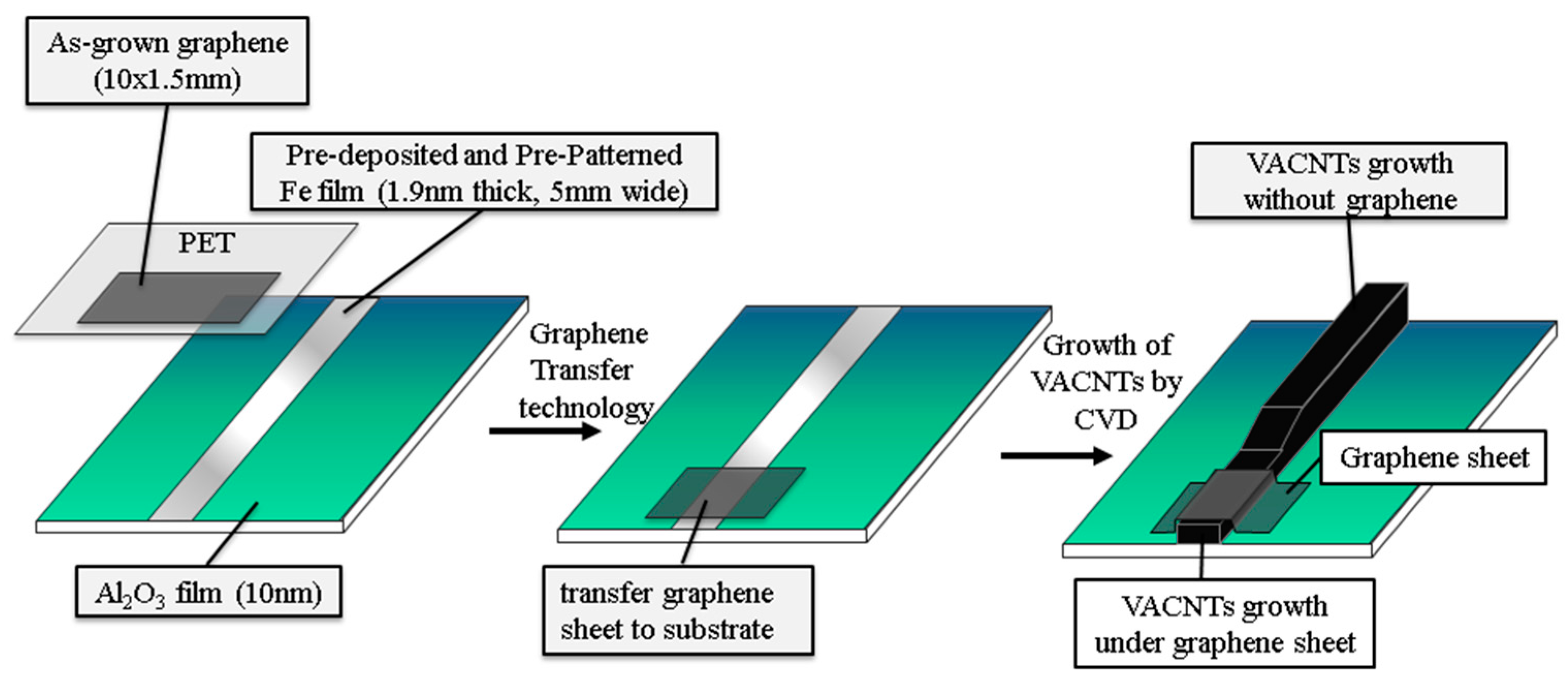
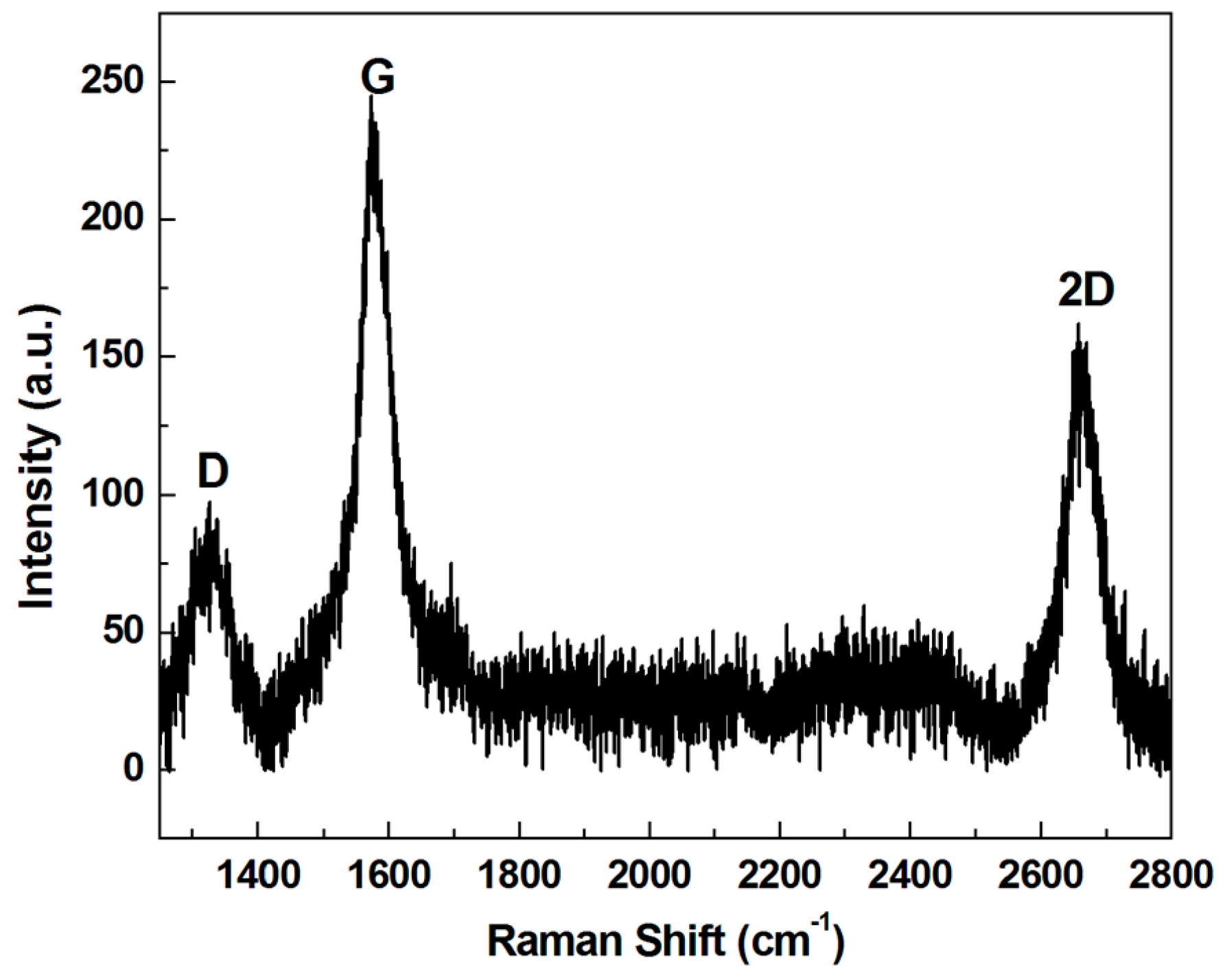
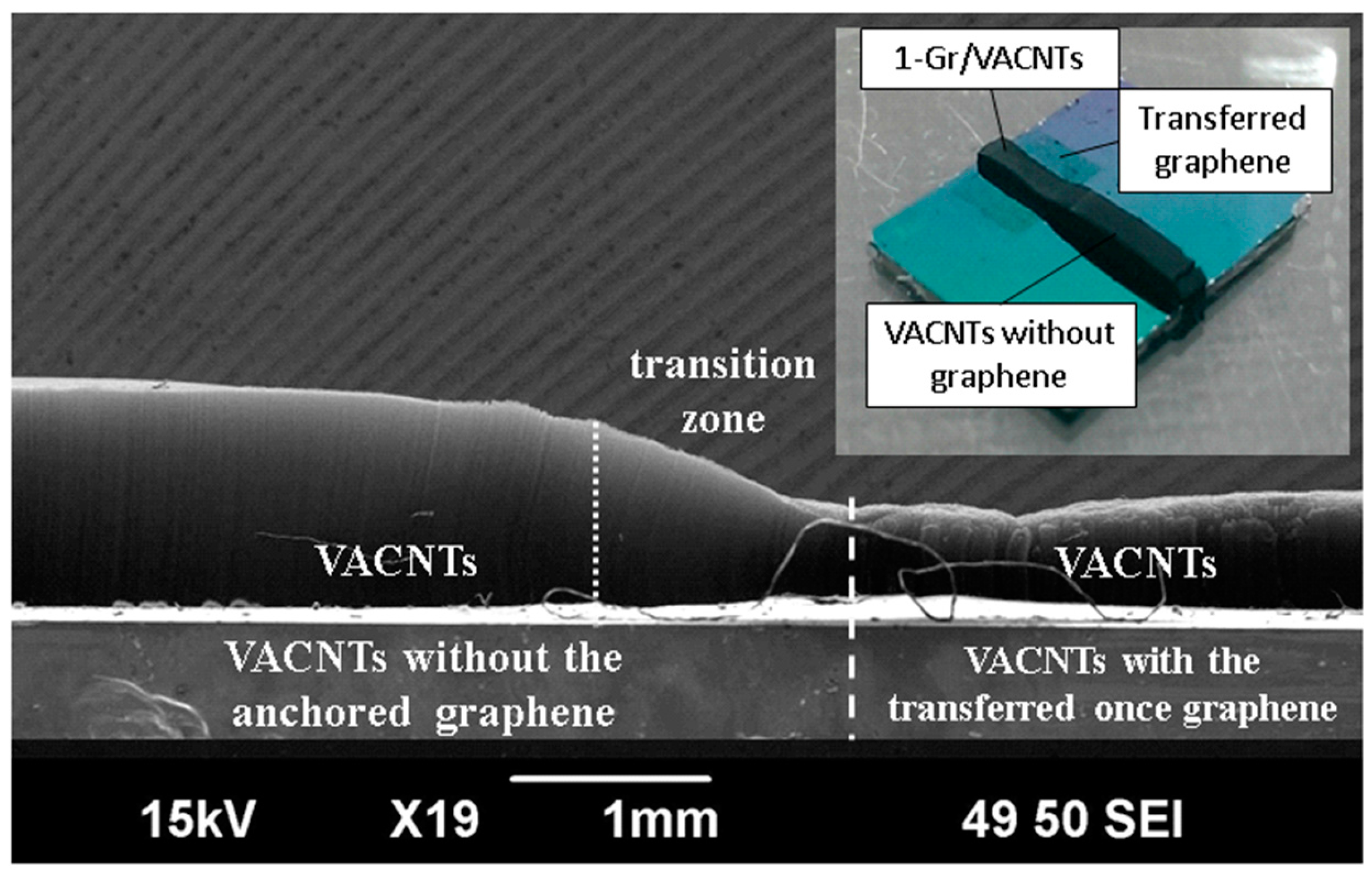
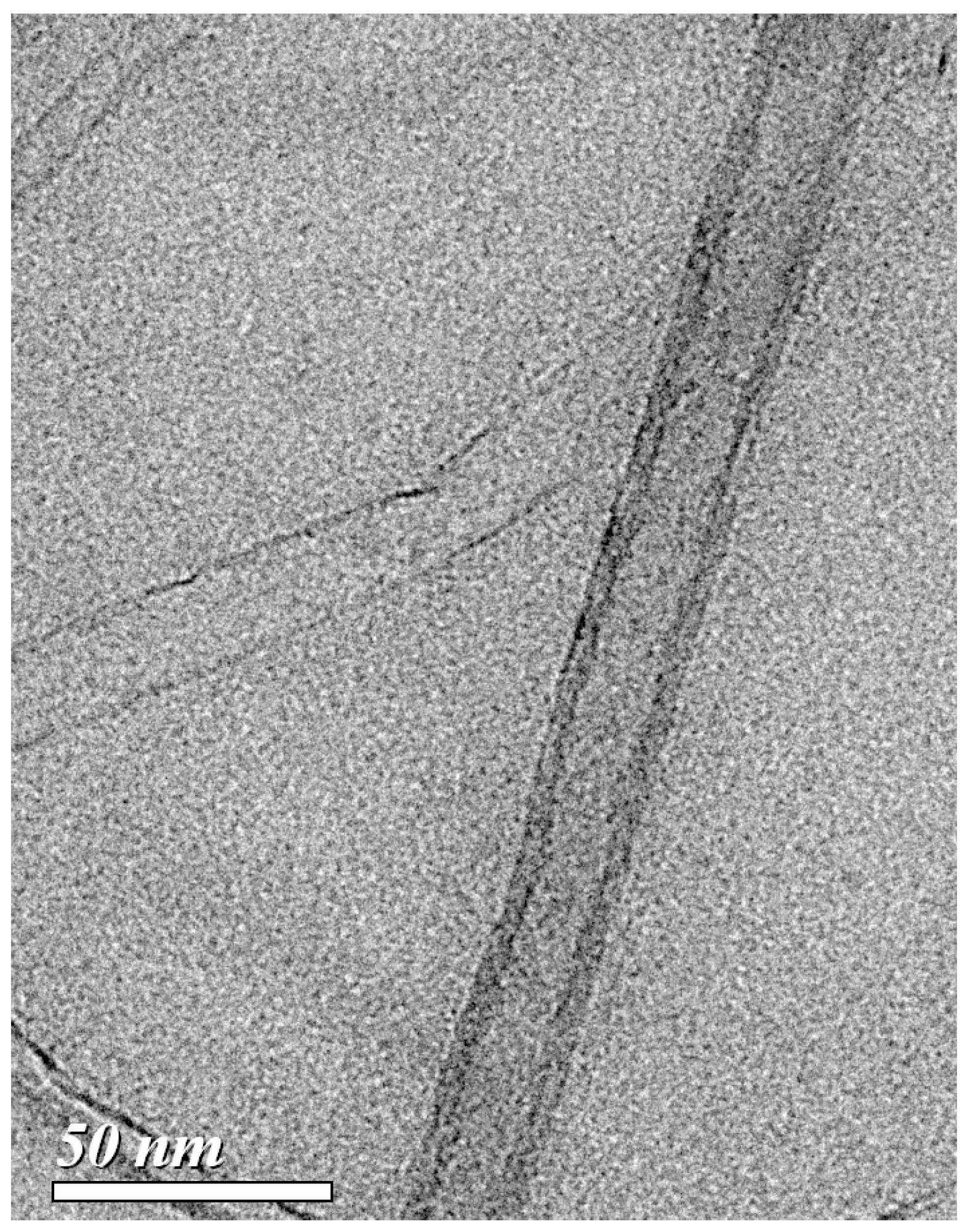

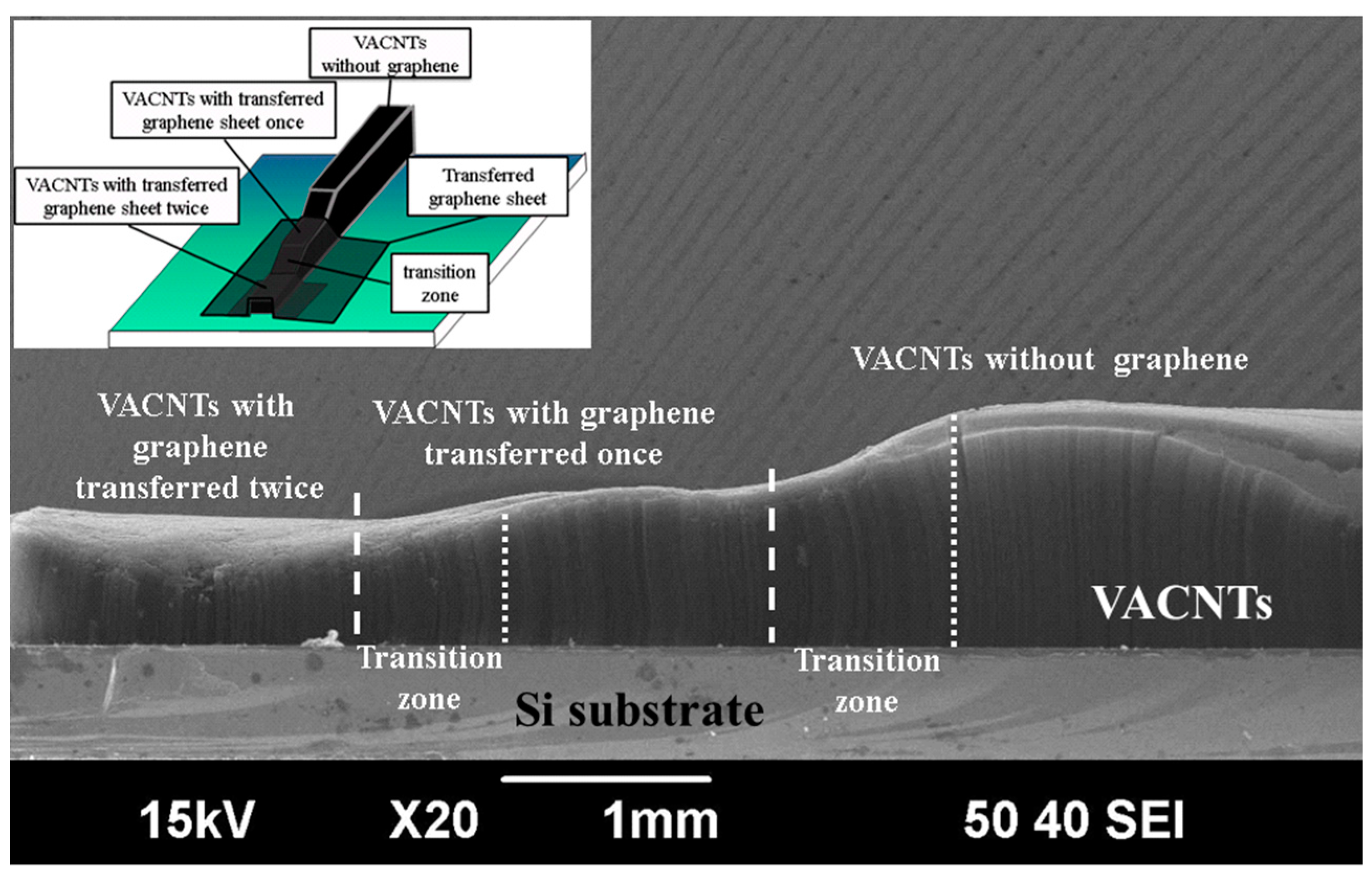
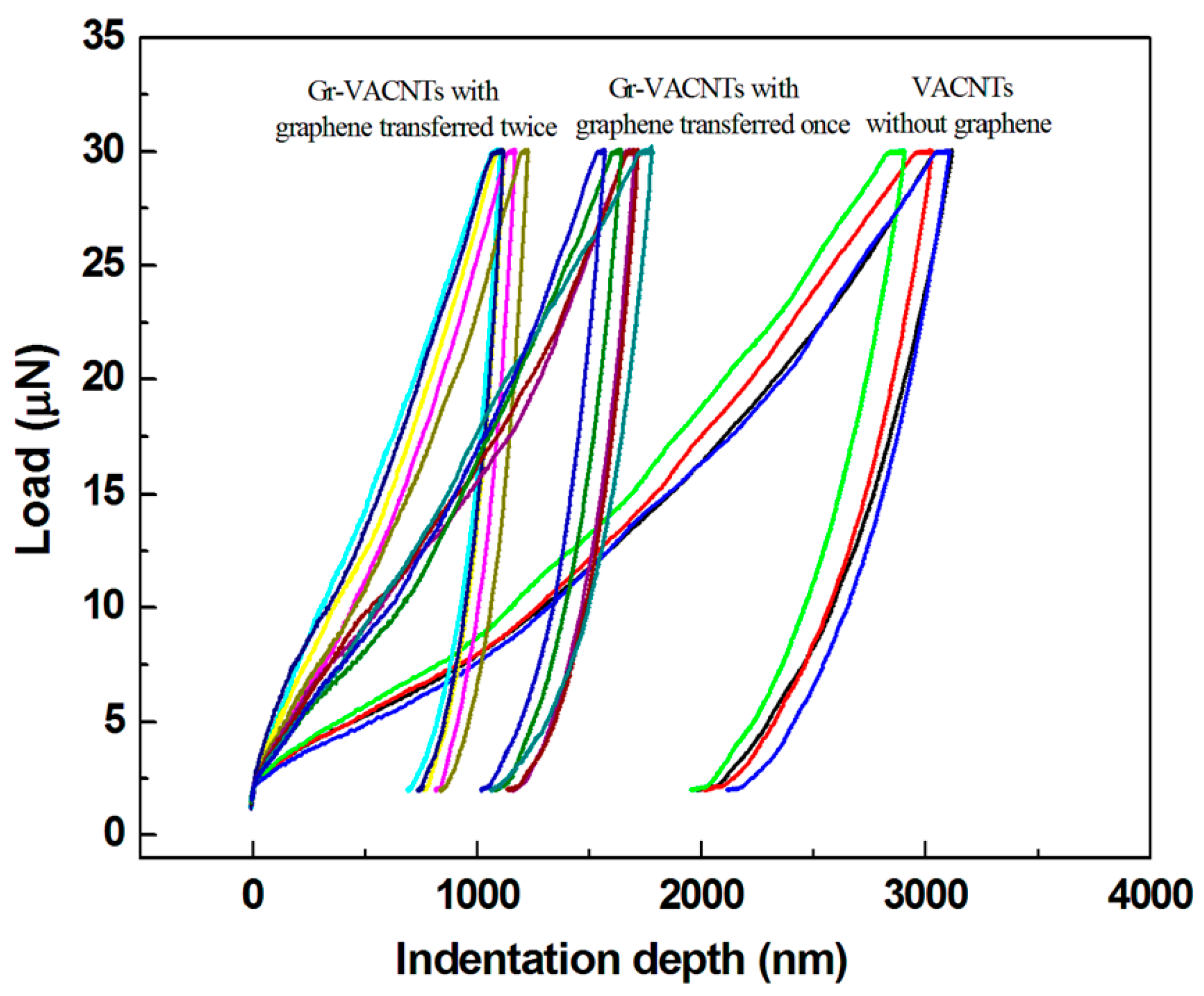

| Material | Reduced Modulus Er (Mpa) | Surface Hardness H (Kpa) |
|---|---|---|
| VACNTs | 1.766 | 149 |
| 1-Gr/VACNTs | 3.633 | 277 |
© 2017 by the authors. Licensee MDPI, Basel, Switzerland. This article is an open access article distributed under the terms and conditions of the Creative Commons Attribution (CC BY) license ( http://creativecommons.org/licenses/by/4.0/).
Share and Cite
Su, C.-C.; Chen, T.-X.; Chang, S.-H. Compressive Strength Enhancement of Vertically Aligned Carbon Nanotube Forests by Constraint of Graphene Sheets. Materials 2017, 10, 206. https://doi.org/10.3390/ma10020206
Su C-C, Chen T-X, Chang S-H. Compressive Strength Enhancement of Vertically Aligned Carbon Nanotube Forests by Constraint of Graphene Sheets. Materials. 2017; 10(2):206. https://doi.org/10.3390/ma10020206
Chicago/Turabian StyleSu, Chih-Chung, Ting-Xu Chen, and Shuo-Hung Chang. 2017. "Compressive Strength Enhancement of Vertically Aligned Carbon Nanotube Forests by Constraint of Graphene Sheets" Materials 10, no. 2: 206. https://doi.org/10.3390/ma10020206





